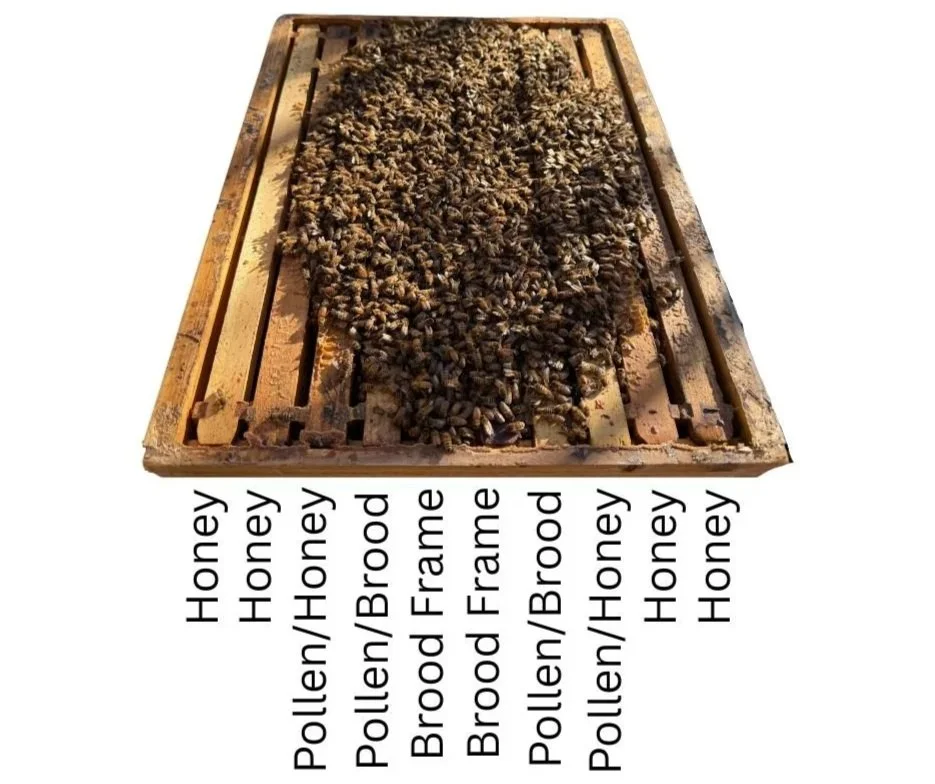Open Apiary September 21, 2025
Today we were instructed by Jared on how your Fall and Winter prep will effect your colony for the Spring. We had 5 adults and 3 children attend this class and some really awesome questions were asked! Interest was expressed about reading a blog, so here goes! With my talents being mostly in conversation and visual learning, I will be taking a crack at the blog world!
Group looks into hive at VSR - Sept. 21, 2025
Let’s review what you need to do for your hives in the Fall. The following advise will be for a 10 frame Langstroth hive set up. Please adapt anything to your personal beekeeping practices. This part of beekeeping should take place Beginning of September and conclude by Mid October.
Feeding: Adding a mix that is 2parts sugar, 1 part water (2:1 simple syrup) to your hive will allow the bees to fill any empty comb and have adequate stores to get through our long winter! For an average 20 frame hive (2 deep boxes), you want the top box to weigh at least 70lbs. The bottom box will be where they start out their cluster to keep the Queen and brood chambers warm and fed. The bottom box will have pollen and honey and the brood frames. **See the Bottom Deep Fall Cluster Image.
Pollen Patties are another food supplement to help your bees grow fatter fuzzier workers. There are Spring and Fall patties so be sure you get the right type of pollen patty for your Fall prep.
For our area, you will still want to have a backup plan for winter feeding. This can be a fondant paddy, a sugar board, or even just dry sugar. They will be HUNGRY in the Spring long before the snow melts and the first pollen appears so give them some dry food before you bundle them up to get them through until the first hive inspection in April.
NOTES on winter feeding:
2:1 Syrup: Sugar and water weigh about the same so to make 2:1 sugar syrup, mix 2 cups of sugar with one cup of water — make enough to fill the feeder of your choice. Do not boil the sugar water. Simply get your water very hot and then add the sugar. Stir until dissolved.
For a Candy Board: Pour dry sugar into a bowl, add just enough water so that you can make a ball that holds together. Pat that into a brick and let it air dry. I put mine in the oven on the lowest heat setting. I leave the door cracked open and in an hour or so, it’s hard. This brick can be placed directly on top of the frames. Here’s a link to a candy board: https://www.honeybeesuite.com/candy-board-feeders-for-honey-bees/ They are super easy to make!!
Dry Camp method: This is super simple and very convenient. Simply place a sheet of newspaper on top of your frames in the upper deep. Pour dry sugar on top of the paper. Leave a little opening in the front so the bees can get up to the sugar. The sugar will absorb any access moisture in the hive. You can use a candy board with this method or simply make a little 1 inch spacer that goes between your upper box and your quilt box.
Bottom Deep Fall Cluster - Taken September 1st 2024
Mite Management mites are a huge threat to a hive in the winter. They will take advantage of the free food and warmth and kill a colony. You have to be sure your mite count is down by checking/treating in the Fall. There are so many ways to treat a hive. Do your research, and do something.
Insulation make a plan for how you will overwinter your hive. The insulation should be to prevent condensation from accumulating at the top of your hive. There are multiple options like Quilt Boxes, Insulation boards, and even a sugar board helps keep condensation down. The sides of the hive can be insulated with a hive wrap as well, being sure the sides are not more insulated than the top. Insulation needs to be added after you are satisfied with the food stores in your hive, and ready to not peak in till the warm days of Spring.
Please reach out via email if you feel like your hive could use an extra set of eyes before it gets too cold.



